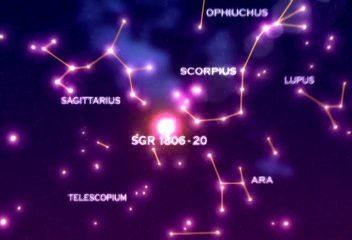Surface temperature 136,000 K Magnitude 17.4 | Radius 1.74 km (0.0000025 R☉) Constellation Sagittarius | |
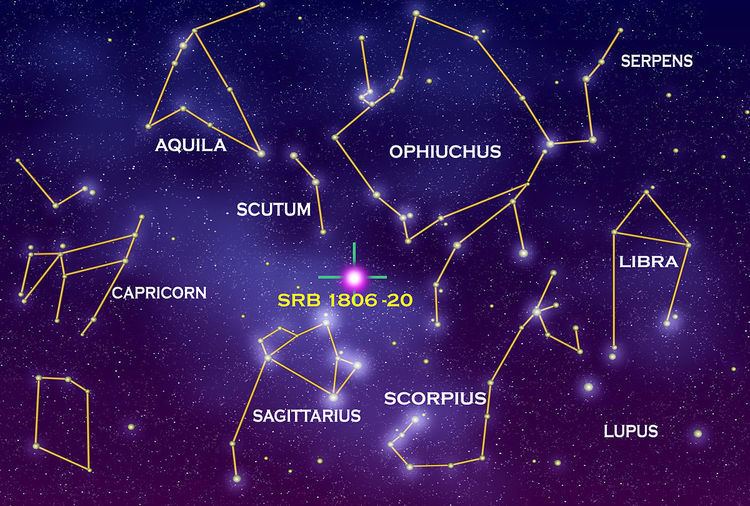 | ||
Mass 2.464 × 10^31 kg (12.39 M☉) Similar SGR 1900+14, LBV 1806‑20, WR 102ka, Sagittarius, Epsilon Sagittarii | ||
Electromagnetic radiation from a magnetar sgr 1806 20
SGR 1806-20 is a magnetar, a particular type of neutron star. It was discovered in 1979 and has been identified as a soft gamma repeater. SGR 1806-20 is located about 14.5 kiloparsecs (50,000 light-years) from Earth on the far side of the Milky Way galaxy in the constellation of Sagittarius. It has a diameter of no more than 20 kilometres (12 mi) and rotates on its axis every 7.5 seconds (30,000 km/h rotation speed at the surface). As of 2016, SGR 1806-20 is the most highly magnetized object ever observed, with a magnetic field over 1015 gauss (1011 tesla) in intensity (compared to the Sun's 1–5 gauss). SGR 1806-20 has a magnetic field that is 1-2 quadrillion (short scale) times stronger than that of the Earth.
Contents
- Electromagnetic radiation from a magnetar sgr 1806 20
- Artist s impression for the gamma ray burst for sgr 1806 20 on december 27 2004
- Explosion
- Location
- References
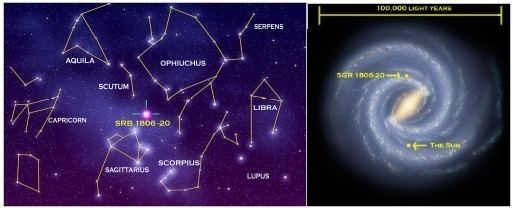
Artist s impression for the gamma ray burst for sgr 1806 20 on december 27 2004
Explosion

A starquake occurred and the radiation from an explosion on the surface of SGR 1806-20 reached Earth on December 27, 2004 (GRB 041227). In terms of gamma rays, the burst had an absolute magnitude around −291. It was the brightest event known to have been sighted on this planet from an origin outside the Solar System. The magnetar released more energy in one-tenth of a second (1.3×1039 J) than the Sun has released in 100,000 years (4×1026 W × 3.2×1012 s = 1.3×1039 J). Such a burst is thought to be the largest explosion observed in the galaxy by humans since the SN 1604 supernova observed by Johannes Kepler in 1604. The gamma rays struck the Earth ionosphere and created more ionization, which briefly expanded the ionosphere.
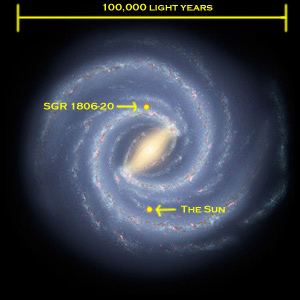
A similar blast within 3 parsecs (10 light years) of Earth would destroy the ozone layer and would be similar in effect to a 12 kt of TNT (50 TJ) nuclear blast at 7.5 km. The nearest known magnetar to earth is 1E 1048.1-5937, located 9,000 light-years away in the constellation Carina.
Location
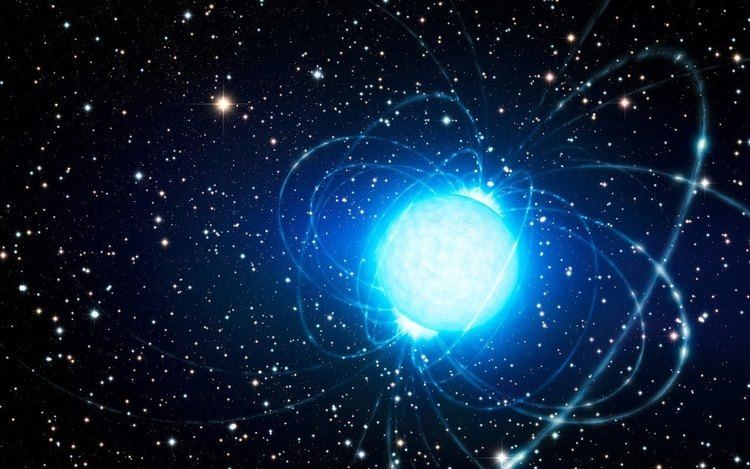
SGR 1806-20 lies at the core of radio nebula G10.0-0.3 and is a member of an open cluster named after it, itself a component of W31, one of the largest H II regions in the Milky Way. Cluster 1806-20 is made up of some highly unusual stars, including at least two carbon-rich Wolf–Rayet stars (WC9d and WCL), two blue hypergiants, and LBV 1806-20, one of the brightest/most massive stars in the galaxy.
